Ageing Studies of Pt- and Pd-Based Catalysts for the Combustion of Lean Methane Mixtures
Abstract
:1. Introduction
2. Materials and Methods
3. Results
4. Discussion
5. Conclusions
Author Contributions
Funding
Data Availability Statement
Conflicts of Interest
References
- Kesselring, J. Catalytic combustion. In Advanced Combustion Methods; Weinberg, J., Ed.; Academic Press: London, UK; pp. 237–275.
- Prasad, R.; Kennedy, L.; Ruckenstein, E. Catalytic combustion. Catal. Rev. Sci. Eng. 1984, 29, 219–267. [Google Scholar] [CrossRef]
- Hayes, R.E.; Kolaczkowski, S.T. Introduction to Catalytic Combustion; Gordon and Breach Science Publishers: Reading, UK, 1997. [Google Scholar]
- Ismagilov, Z.; Kerzhentsev, M. Catalytic fuel combustion—A way of reducing emission of nitrogen oxides. Catal. Rev. Sci. Eng. 1990, 32, 51–103. [Google Scholar] [CrossRef]
- Sadamori, H. Application concepts and evaluation of small-scale catalytic combustors for natural gas. Catal. Today 1999, 47, 325–338. [Google Scholar] [CrossRef]
- Etemad, S.; Karim, H.; Smith, L.; Pfefferle, W. Advanced technology catalytic combustor for high temperature ground power gas turbine applications. Catal. Today 1999, 47, 305–313. [Google Scholar] [CrossRef]
- Forzatti, P. Status and perspectives of catalytic combustion for gas turbines. Catal. Today 2003, 83, 3–188. [Google Scholar] [CrossRef]
- Hayes, R.E. Catalytic solutions for fugitive methane emissions in the oil and gas sector. Chem. Eng. Sci. 2004, 59, 4073–4080. [Google Scholar] [CrossRef]
- Zanoletti, M.; Klvana, D.; Kirchnerova, J.; Perrier, M.; Guy, C. Auto-cyclic reactor: Design and evaluation for the removal of unburned methane from emissions of natural gas engines. Chem. Eng. Sci. 2009, 64, 945–954. [Google Scholar] [CrossRef]
- Kolios, G.; Gritsch, A.; Morillo, A.; Tuttlies, U.; Bernnat, J.; Opferkuch, F.; Eigenberger, G. Heat-integrated reactor concepts for catalytic reforming and automotive exhaust purification. Appl. Catal. B Environ. 2007, 70, 16–30. [Google Scholar] [CrossRef]
- Bernnat, J.; Rink, M.; Tuttlies, U.; Danner, T.; Nieken, U.; Eigenberger, G. Heat-integrated concepts for automotive exhaust purification. Top. Catal. 2009, 52, 2052–2057. [Google Scholar] [CrossRef]
- Chen, J.; Arandiyan, H.; Gao, X.; Li, J. Recent advances in catalysts for methane combustion. Catal. Surv. Asia 2015, 19, 140–171. [Google Scholar] [CrossRef]
- Cimino, S.; Di Benedetto, A.; Pirone, R.; Russo, G. Transient behaviour of perovskite-based monolithic reactors in the catalytic combustion of methane. Catal. Today 2001, 69, 95–103. [Google Scholar] [CrossRef]
- Park, S.; Hwang, H.; Moon, J. Catalytic combustion of methane over rare earth stannate pyrochlore. Catal. Lett. 2003, 87, 219–223. [Google Scholar] [CrossRef]
- Feng, S.; Wang, Z.; Yang, P. Effect of Substitution of Cobalt for Iron in Sr4Fe6O13-delta on the Catalytic Activity for Methane Combustion. Chin. J. Chem. 2011, 29, 451–454. [Google Scholar] [CrossRef]
- Yang, J.; Guo, Y. Nanostructured perovskite oxides as promising substitutes of noble metals catalysts for catalytic combustion of methane. Chin. Chem. Lett. 2018, 29, 252–260. [Google Scholar] [CrossRef]
- Zhu, W.; Jin, J.; Chen, X.; Li, C.; Wang, T.; Tsang, C.; Liang, C. Enhanced activity and stability of La-doped CeO2 monolithic catalysts for lean-oxygen methane combustion. Environ. Sci. Pollut. Res. 2018, 25, 5643–5654. [Google Scholar] [CrossRef]
- Li, S.; Zhang, Y.; Wang, Z.; Du, W.; Zhu, G. Morphological effect of CeO2 catalysts on their catalytic performance in lean methane combustion. Chem. Lett. 2020, 49, 461–464. [Google Scholar] [CrossRef]
- Chen, J.; Zhang, X.; Arandiyan, H.; Peng, Y.; Chang, H.; Li, J. Low temperature complete combustion of methane over cobalt chromium oxides catalysts. Catal. Today 2013, 201, 12–18. [Google Scholar] [CrossRef]
- Choya, A.; de Rivas, B.; González-Velasco, J.; Gutiérrez-Ortiz, J.; López-Fonseca, R. Oxidation of residual methane from VNG vehicles over Co3O4-based catalysts: Comparison among bulk, Al2O3-supported and Ce-doped catalysts. Appl. Catal. B Environ. 2018, 237, 844–854. [Google Scholar] [CrossRef]
- Liotta, L.; Di Carlo, G.; Pantaleo, G.; Deganello, G. Co3O4/CeO2 and Co3O4/CeO2–ZrO2 composite catalysts for methane combustion: Correlation between morphology reduction properties and catalytic activity. Catal. Commun. 2005, 6, 329–336. [Google Scholar] [CrossRef]
- Cullis, C.F.; Willatt, B.M. Oxidation of methane over supported precious metal catalysts. J. Catal. 1983, 83, 267–285. [Google Scholar] [CrossRef]
- Gélin, P.; Primet, M. Complete oxidation of methane at low temperature over noble metal based catalysts: A review. App. Cat. B Environ. 2002, 39, 1–37. [Google Scholar] [CrossRef]
- Choudhary, T.; Banerjee, S.; Choudhary, V. Catalysts for combustion of methane and lower alkanes. Appl. Catal. A Gen. 2002, 234, 1–23. [Google Scholar] [CrossRef]
- Ciuparu, D.; Lyubovsky, M.; Altman, E.; Pfefferle, L.; Datye, A. Catalytic combustion of methane over palladium-based catalysts. Catal. Rev. Sci. Eng. 2002, 44, 593–649. [Google Scholar] [CrossRef]
- Monai, M.; Montini, T.; Gorte, R.; Fornasiero, P. Catalytic Oxidation of Methane: Pd and Beyond. Eur. J. Inorg. Chem. 2018, 25, 2884–2893. [Google Scholar] [CrossRef]
- Becker, E.; Carlsson, P.A.; Grönbeck, H.; Skoglundh, M. Methane oxidation over alumina supported platinum investigated by time-resolved in situ XANES spectroscopy. J. Catal. 2007, 252, 11–17. [Google Scholar] [CrossRef]
- Deutschmann, O.; Maier, L.; Riedel, U.; Stroemman, A.; Dibble, R. Hydrogen assisted catalytic combustion of methane on platinum. Catal. Today 2000, 59, 141–150. [Google Scholar] [CrossRef]
- Bui, P.; Vlachos, D.; Westmoreland, P. Catalytic ignition of methane/oxygen mixtures over platinum surfaces: Comparison of detailed simulations and experiments. Surf. Sci. 1997, 385, L1029–L1034. [Google Scholar] [CrossRef]
- Deutschmann, O.; Behrendt, F.; Warnatz, J. Modeling and simulation of heterogeneous oxidation of methane on a platinum foil. Catal. Today 1994, 21, 461–470. [Google Scholar] [CrossRef]
- Reinke, M.; Mantzaras, J.; Bombach, R.; Schenker, S.; Yylli, N. Effects of H2O and CO2 Dilution on the Catalytic and Gas-Phase Combustion of Methane, over Platinum at Elevated Pressures. Combust. Sci. Tech 2006, 179, 553–600. [Google Scholar] [CrossRef]
- Mazzarino, I.; Barresi, A. Catalytic combustion of VOC mixtures in a monolith reactor. Catal. Today 1993, 17, 335–348. [Google Scholar] [CrossRef]
- Niwa, M.; Awano, K.; Murakami, Y. Activity of supported platinum catalysts for methane oxidation. Appl. Catal. 1983, 7, 317–325. [Google Scholar] [CrossRef]
- O’Connell, M.; Kolb, G.; Zapf, R.; Men, Y.; Hessel, V. Bimetallic catalysts for the catalytic combustion of methane using microreactor technology. Catal. Today 2009, 144, 306–311. [Google Scholar] [CrossRef]
- Trimm, D.; Lam, C. The combustion of methane on platinum-alumina fibre catalysts I Kinetics and Mechanism. Chem. Eng. Sci. 1980, 35, 1405–1413. [Google Scholar] [CrossRef]
- Jodeiri, N.; Wu, L.; Mmbaga, J.; Hayes, R.E.; Wanke, S.E. Catalytic Combustion of VOC in a Counter-diffusive Reactor. Catal. Today 2010, 155, 147–153. [Google Scholar] [CrossRef]
- Cullis, C.; Nevell, T.; Trimm, D. Role of the catalyst support in the oxidation of methane over palladium. J. Chem. Soc. Faraday Trans. 1 Phys. Chem. Condens. Phases 1972, 68, 1406–1412. [Google Scholar] [CrossRef]
- Schwartz, W.; Ciuparu, D.; Pfefferle, L. Combustion of methane over palladium-based catalysts: Catalytic deactivation and role of the Support. J. Phys. Chem. C 2012, 116, 8587–8593. [Google Scholar] [CrossRef]
- Schwartz, W.; Pfefferle, L.D. Combustion of methane over palladium-based catalysts: Support interactions. J. Phys. Chem. C 2012, 116, 8571–8578. [Google Scholar] [CrossRef]
- Escandon, L.; Ordonez, S.; Vega, A.; Diez, F. Oxidation of methane over palladium catalysts: Effect of the support. Chemosphere 2005, 58, 9–17. [Google Scholar] [CrossRef]
- Kumar, R.; Hayes, R.; Semagina, N. Effect of support on Pd-catalyzed methane-lean combustion in the presence of water: Review. Catal. Today 2021, 382, 82–95. [Google Scholar] [CrossRef]
- Garbowski, E.; Feumi-Jantou, C.; Mouaddib, N.; Primet, M. Catalytic combustion of methane over palladium supported on alumina catalysts: Evidence for reconstruction of particles. Appl. Catal. A Gen. 1994, 109, 277–292. [Google Scholar] [CrossRef]
- Friberg, I.; Sadokhina, N.; Olsson, L. Complete methane oxidation over Ba modified Pd/Al2O3: The effect of water vapour. Appl. Catal. B Environ. 2018, 231, 242–250. [Google Scholar] [CrossRef]
- Demoulin, O.; Navez, M.; Ruiz, P. Investigation of the behavior of a Pd/γ-Al2O3 catalyst during methane combustion reaction using in situ DRIFT spectroscopy. Appl. Catal. A Gen. 2005, 295, 59–70. [Google Scholar] [CrossRef]
- Demoulin, O.; Navez, M.; Gaigneaux, E.; Ruiz, P.; Mamede, A.; Granger, P.; Payen, E. Operando resonance Raman spectroscopic characterisation of the oxidation state of palladium in Pd/g-Al2O3 catalysts during the combustion of methane. Phys. Chem. Chem. Phys. 2003, 5, 4394–4401. [Google Scholar] [CrossRef]
- Datye, A.; Bravo, J.; Nelson, T.; Atanasova, P.; Lyubovsky, M.; Pfefferle, L. Catalyst microstructure and methane oxidation reactivity during the Pd-PdO transformation on alumina supports. Appl. Catal. A Gen. 2000, 198, 179–196. [Google Scholar] [CrossRef]
- Ciuparu, D.; Perkins, E.; Pfefferle, L. In situ DR-FTIR investigation of surface hydroxyls on γ-Al2O3 supported PdO catalysts during methane combustion. Appl. Catal. A Gen. 2004, 263, 145–153. [Google Scholar] [CrossRef]
- Castellazzi, P.; Groppi, G.; Forzatti, P.; Baylet, A.; Marecot, P.; Duprez, D. Role of Pd loading and dispersion on redox behaviour and CH4 combustion activity of Al2O3 supported catalysts. Catal. Today 2010, 155, 18–26. [Google Scholar] [CrossRef]
- Hicks, R.; Qi, H.; Young, M.; Lee, R. Effect of catalyst structure on methane oxidation over palladium on alumina. J. Catal. 1990, 122, 295–306. [Google Scholar] [CrossRef]
- Hong, E.; Kim, C.; Lim, D.; Cho, H.; Shin, C. Catalytic methane combustion over Pd/ZrO2 catalysts: Effects of crystalline structure and textural properties. Appl. Catal. B Environ. 2018, 232, 544–552. [Google Scholar] [CrossRef]
- Guerrero, S.; Araya, P.; Wolf, E. Methane oxidation on Pd supported on high area zirconia catalysts. Appl. Catal. A Gen. 2006, 298, 243–253. [Google Scholar] [CrossRef]
- Fujimoto, F.; Ribiero, R.; Avalos Borja, A.; Iglesia, E. Structure and reactivity of PdOx/ZrO2 catalysts for methane oxidation at low temperatures. J. Catal. 1998, 179, 431–442. [Google Scholar] [CrossRef]
- Carstens, J.; Su, S.; Bell, A. Factors Affecting the Catalytic Activity of Pd/ZrO2 for the Combustion of Methane. J. Catal. 1998, 176, 136–142. [Google Scholar] [CrossRef]
- Ibashi, W.; Groppi, G.; Forzatti, P. Kinetic measurement of CH4 combustion over a 10% PdO/ZrO2 catalyst using an annular flow micro reactor. Catal. Today 2003, 83, 115–129. [Google Scholar] [CrossRef]
- Araya, P.; Guerrero, S.; Robertson, J.; Gracia, F. Methane combustion over Pd/SiO2 catalysts with different degrees of hydrophobicity. Appl. Catal. A Gen. 2005, 283, 225–233. [Google Scholar] [CrossRef]
- Bassil, J.; Al Barazi, A.; Da Costa, P.; Boutros, M. Catalytic combustion of methane over mesoporous silica supported palladium. Catal. Today 2011, 176, 36–40. [Google Scholar] [CrossRef]
- Hoyos, L.; Praliaud, H.; Primet, M. Catalytic combustion of methane over palladium supported on alumina and silica in presence of hydrogen sulfide. Appl. Catal. A Gen. 1993, 98, 125–138. [Google Scholar] [CrossRef]
- Gannouni, A.; Albela, B.; Said Zina, M.; Bonneviot, L. Metal dispersion, accessibility and catalytic activity in methane oxidation of mesoporous templated aluminosilica supported palladium. Appl. Catal. A Gen. 2013, 464–465, 116–127. [Google Scholar] [CrossRef]
- Ercolino, G.; Grzybek, G.; Stelmachowski, P.; Specchia, S.; Kotarba, A.; Specchia, V. Pd/Co3O4-based catalysts prepared by solution combustion synthesis for residual methane oxidation in lean conditions. Catal. Today 2015, 257, 66–71. [Google Scholar] [CrossRef]
- Li, Z.; Xu, G.; Hoflund, G. In situ IR studies on the mechanism of methane oxidation over Pd/Al2O3 and Pd/Co3O4 catalysts. Fuel Process. Technol. 2003, 84, 1–11. [Google Scholar] [CrossRef]
- Hoffmann, M.; Kreft, S.; Georgi, G.; Fulda, G.; Pohla, M.; Seeburg, D.; Berger-Karin, C.; Kondratenko, E.; Wohlrab, S. Improved catalytic methane combustion of Pd/CeO2 catalysts via porous glass integration. Appl. Catal. B Environ. 2015, 179, 313–320. [Google Scholar] [CrossRef]
- Lei, Y.; Li, W.; Liu, Q.; Lin, Q.; Zhenga, X.; Huanga, Q.; Guan, S.; Wanga, X.; Wang, C.; Li, F. Typical crystal face effects of different morphology ceria on the activity of Pd/CeO2 catalysts for lean methane combustion. Fuel 2018, 233, 10–20. [Google Scholar] [CrossRef]
- Huang, Q.; Li, W.; Lei, Y.; Guan, S.; Zheng, X.; Pan, Y.; Wen, W.; Zhu, J.; Zhang, H.; Lin, Q. Catalytic Performance of Novel Hierarchical Porous Flower-Like NiCo2O4 Supported Pd in Lean Methane Oxidation. Catal. Lett. 2018, 148, 2799–2811. [Google Scholar] [CrossRef]
- Roth, D.; Gelin, P.; Tena, E.; Primet, M. Combustion of methane at low temperature over Pd and Pt catalysts supported on Al2O3, SnO2 and Al2O3-grafted SnO2. Top. Catal. 2001, 16/17, 77–82. [Google Scholar] [CrossRef]
- Urfels, L.; Gelin, P.; Primet, M.; Tena, E. Complete oxidation of methane at low temperature over Pt catalysts supported on high surface area SnO2. Top. Catal. 2004, 30/31, 427–432. [Google Scholar] [CrossRef]
- Kinnunen, N.; Suvanto, M.; Moreno, M.; Savimaki, A.; Kallinen, K.; Kinnunen, T.; Pakkanen, T. Methane oxidation on alumina supported palladium catalysts: Effect of Pd precursor and solvent. Appl. Catal. A Gen. 2009, 370, 78–87. [Google Scholar] [CrossRef]
- Lu, Y.; Michalow, K.; Matam, S.; Winkler, A.; Maeglia, A.; Yoona, S.; Heele, A.; Weidenkaffa, A.; Ferri, D. Methane abatement under stoichiometric conditions on perovskite-supported palladium catalysts prepared by flame spray synthesis. Appl. Catal. B Environ. 2014, 144, 631–643. [Google Scholar] [CrossRef]
- Lu, Y.; Eyssler, A.; Otala, E.; Matam, S.; Brunko, O.; Weidenkaff, A.; Ferri, D. Influence of the synthesis method on the structure of Pd-substituted perovskite catalysts for methane oxidation. Catal. Today 2013, 208, 42–47. [Google Scholar] [CrossRef]
- Auvray, X.; Lindholm, A.; Milh, M.; Olsson, L. The addition of alkali and alkaline earth metals to Pd/Al2O3 to promote methane combustion. Effect of Pd and Ca loading. Catal. Today 2018, 299, 212–218. [Google Scholar] [CrossRef]
- Colussi, S.; Trovarelli, A.; Cristiani, C.; Lietti, L.; Groppi, G. The influence of ceria and other rare earth promoters on palladium-based methane combustion catalysts. Catal. Today 2012, 180, 124–130. [Google Scholar] [CrossRef]
- Kang, T.; Kim, J.; Kang, S.; Seo, G. Promotion of methane combustion activity of Pd catalyst by titania loading. Catal. Today 2000, 59, 87–93. [Google Scholar] [CrossRef]
- Bounechada, D.; Groppi, G.; Forzatti, P.; Kallinen, K.; Kinnunen, T. Effect of periodic lean/rich switch on methane conversion over a Ce–Zr promoted Pd-Rh/Al2O3 catalyst in the exhausts of natural gas vehicles. Appl. Catal. B Environ. 2012, 119–120, 91–99. [Google Scholar] [CrossRef]
- Ersson, A.; Kušar, H.; Carroni, R.; Griffin, T.; Järås, S. Catalytic combustion of methane over bimetallic catalysts a comparison between a novel annular reactor and a high-pressure reactor. Catal. Today 2003, 83, 265–277. [Google Scholar] [CrossRef]
- Kul Ryu, C.; Wong Ryoo, M.; Soo Ryu, I.; Kang, S. Catalytic combustion of methane over supported bimetallic Pd catalysts: Effects of Ru or Rh addition. Catal. Today 1999, 47, 141–147. [Google Scholar] [CrossRef]
- Lyubovsky, M.; Smith, L.; Castaldi, M.; Karim, H.; Nentwick, B.; Etemad, S.; LaPierre, R.; Pfefferle, W. Catalytic combustion over platinum group catalysts: Fuel-lean versus fuel-rich operation. Catal. Today 2003, 83, 71–84. [Google Scholar] [CrossRef]
- Oh, S.; Mitchell, P. Effects of rhodium addition on methane oxidation behavior of alumina-supported noble metal catalysts. Appl. Catal. B Environ. 1994, 5, 165–179. [Google Scholar] [CrossRef]
- Yang, N.; Liu, J.; Sun, Y.; Zhu, Y. Au@PdOx with a PdOx-rich shell and Au-rich core embedded in Co3O4 nanorods for catalytic combustion of methane. Nanoscale 2019, 9, 4108–4109. [Google Scholar] [CrossRef]
- Venezia, A.; Murania, R.; Pantaleo, G.; Deganello, G. Pd and PdAu on mesoporous silica for methane oxidation: Effect of SO2. J. Catal. 2007, 251, 94–102. [Google Scholar] [CrossRef]
- Miao, S.; Deng, Y. Au-Pt/Co3O4 catalyst for methane combustion. Appl. Catal. B Environ. 2001, 31, l1–l4. [Google Scholar] [CrossRef]
- Lapisardi, G.; Urfels, L.; Gelin, P.; Primet, M.; Kaddouri, A.; Garbowski, E.; Toppi, S.; Tena, E. Superior catalytic behaviour of Pt-doped Pd catalysts in the complete oxidation of methane at low temperature. Catal. Today 2006, 117, 564–568. [Google Scholar] [CrossRef]
- Larpisardi, G.; Gélin, P.; Kaddouri, A.; Garbowski, E.; Da Costa, S. Pt-Pd bimetallic catalysts for methane emissions abatement. Top. Catal. 2007, 42–43, 461–464. [Google Scholar]
- Kinnunen, N.; Hirvi, J.; Suvanto, M.; Pakkanen, T. Methane combustion activity of Pd–PdOx–Pt/Al2O3 catalyst: The role of platinum promoter. J. Mol. Catal. A Chem. 2012, 356, 20–28. [Google Scholar] [CrossRef]
- Bugosh, G.; Easterling, V.; Rusakova, I.; Harold, M. Anomalous steady-state and spatio-temporal features of methane oxidation on Pt/Pd/Al2O3 monolith spanning lean and rich condition. Appl. Catal. B Environ. 2015, 165, 68–78. [Google Scholar] [CrossRef]
- Watanabe, T.; Kawashima, K.; Tagawa, Y.; Tashiro, K.; Anoda, H.; Ichioka, K.; Sumiya, S.; Zhang, G. New DOC for Light Duty Diesel DPF System; SAE Technical Paper Series; SAE: Warrendale, PA, USA, 2007. [Google Scholar]
- Nomura, K.; Noro, K.; Nakamura, Y.; Yazawa, Y.; Yoshida, H.; Satsuma, A.; Hattori, T. Pd–Pt bimetallic catalyst supported on SAPO-5 for catalytic combustion of diluted methane in the presence of water vapor. Catal. Lett. 1998, 53, 167–169. [Google Scholar] [CrossRef]
- Persson, K.; Jansson, K.; Järås, S. Characterisation and microstructure of Pd and bimetallic Pd–Pt catalysts during methane oxidation. J. Catal. 2007, 245, 401–414. [Google Scholar] [CrossRef]
- Nassiri, H.; Hayes, R.E.; Semagina, N. Stability of Pd-Pt catalysts in low-temperature wet methane combustion: Metal ratio and particle reconstruction. Chem. Eng. Sci. 2018, 186, 44–51. [Google Scholar] [CrossRef]
- Goodman, E.; Dai, S.; Yang, A.; Wrasman, C.; Gallo, A.; Bare, S.; Hoffman, A.; Jaramillo, T.; Graham, G.; Pan, X.; et al. Uniform Pt/Pd Bimetallic Nanocrystals Demonstrate Platinum Effect on Palladium Methane Combustion Activity and Stability. ACS Catal. 2017, 7, 4372–4380. [Google Scholar] [CrossRef]
- Persson, K.; Ersson, A.; Jansson, K.; Fierro, J.; Jaras, S. Influence of molar ratio on Pd–Pt catalysts for methane combustion. J. Catal. 2006, 243, 14–24. [Google Scholar] [CrossRef]
- Yamamoto, H.; Uchida, H. Oxidation of methane over Pt and Pd supported on alumina in lean-burn natural-gas engine exhaust. Catal. Today 1998, 45, 147–151. [Google Scholar] [CrossRef]
- Semagina, N.; Nassiri, H.; Lee, K.; Hu, Y.; Hayes, R.E.; Scott, R.W.J. Water shifts PdO-catalyzed lean methane combustion to Pt-catalyzed rich combustion in Pd-Pt catalysts: In-situ X-ray absorption spectroscopy. J. Catal. 2017, 352, 649–656. [Google Scholar]
- Nassiri, H.; Lee, K.; Hu, Y.; Hayes, R.E.; Scott, R.W.J.; Semagina, N. Platinum inhibits low-temperature dry lean methane combustion via palladium reduction in Pd-Pt/Al2O3: An in-situ X-ray absorption study. ChemPhysChem 2017, 18, 238–244. [Google Scholar] [CrossRef]
- Chen, M.; Schmidt, L.D. Morphology and composition of Pt-Pd alloy crystallites on SiO2 in reactive atmospheres. J. Catal. 1979, 56, 198–218. [Google Scholar] [CrossRef]
- Willis, J.; Gallo, A.; Sokaras, D.; Aljama, H.; Nowak, S.; Goodman, E.; Wu, L.; Tassone, C.; Jaramillo, T.; Abild-pedersen, F.; et al. Systematic Structure–Property Relationship Studies in Palladium-Catalyzed Methane Complete Combustion. ACS Catal. 2017, 7, 7810–7821. [Google Scholar] [CrossRef]
- Burch, R. Low NOx options in catalytic combustion and emission control. Catal. Today 1997, 35, 27–36. [Google Scholar] [CrossRef]
- Persson, K.; Pfefferle, L.; Schwartz, W.; Ersson, A.; Järås, S. Stability of palladium-based catalysts during catalytic combustion of methane: The influence of water. Appl. Catal. B Environ. 2007, 74, 242–250. [Google Scholar] [CrossRef]
- van Giezen, J.; Van den Berg, F.; Kleinen, J.; Van Dillen, A.; Geus, J. The effect of water on the activity of supported palladium catalysts in the catalytic combustion of methane. Catal. Today 1999, 47, 287–293. [Google Scholar] [CrossRef]
- Toso, A.; Colussi, S.; Padigapaty, S.; de Leitenburg, C.; Trovarelli, A. High stability and activity of solution combustion synthesized Pd-based catalysts for methane combustion in presence of water. Appl. Catal. B Environ. 2018, 230, 237–245. [Google Scholar] [CrossRef]
- Gélin, P.; Urfels, L.; Primet, M.; Tena, E. Complete oxidation of methane at low temperature over Pt and Pd catalysts for the abatement of lean-burn natural gas fuelled vehicles emissions: Influence of water and sulphur containing compounds. Catal. Today 2003, 83, 45–57. [Google Scholar] [CrossRef]
- Ciuparu, D.; Katsikis, N.; Pfefferle, L. Temperature and time dependence of the water inhibition effect on supported palladium catalyst for methane combustion. Appl. Catal. A Gen. 2001, 216, 209–215. [Google Scholar] [CrossRef]
- Ciuparu, D.; Pfefferle, L. Support and water effects on palladium based methane combustion catalysts. Appl. Catal. A Gen. 2001, 209, 415–428. [Google Scholar] [CrossRef]
- Escandón, L.; Niño, D.; Díaz, E.; Ordóñez, S.; Díez, F. Effect of hydrothermal ageing on the performance of Ce-promoted PdO/ZrO2 for methane combustion. Catal. Commun. 2008, 9, 2291–2296. [Google Scholar] [CrossRef]
- Gholami, R.; Alyani, M.; Smith, K. Deactivation of Pd Catalysts by water during low temperature methane oxidation relevant to natural gas vehicle converters. Catalysts 2015, 5, 561–594. [Google Scholar] [CrossRef]
- Burch, R.; Urbano, F.; Loader, P. Methane combustion over palladium catalysts: The effect of carbon dioxide and water on activity. Appl. Catal. A Gen. 1995, 123, 173–184. [Google Scholar] [CrossRef]
- Monai, M.; Montini, T.; Chen, C.; Fonda, E.; Gorte, R.; Fornasiero, P. Methane catalytic combustion over hierarchical Pd@CeO2/Si-Al2O3: Effect of the Presence of Water. ChemCatChem 2015, 7, 2038–2046. [Google Scholar] [CrossRef]
- Ciuparu, D.; Pfefferle, L.; Bozon-Verduraz, F. Oxygen Exchange between Palladium and Oxide Supports in Combustion Catalysts. J. Phys. Chem. B 2002, 106, 3434–3442. [Google Scholar] [CrossRef]
- Burch, R.; Crittle, D.; Hayes, M. C-H bond activation in hydrocarbon oxidation on heterogeneous catalysts. Catal. Today 1999, 47, 229–234. [Google Scholar] [CrossRef]
- Barrett, W.; Nasr, S.; Shen, J.; Hu, Y.; Hayes, R.; Scott, R.; Semagina, N. Strong metal-support interactions in Pd/Co3O4catalyst in wet methane combustion: In situ X-ray absorption study. Catal. Sci. Technol. 2020, 10, 4229–4236. [Google Scholar] [CrossRef]
- Wanke, S.; Flynn, P. The sintering of supported metal catalysts. Catal. Rev. Sci. Eng. 1975, 12, 93–135. [Google Scholar] [CrossRef]
- Abbasi, R.; Wu, L.; Wanke, S.E.; Hayes, R.E. Kinetics of Methane Combustion over Pt and Pt-Pd catalysts. Chem. Eng. Res. Des. 2012, 90, 1930–1942. [Google Scholar] [CrossRef]
- Abbasi, R.; Huang, G.; Istratescu, G.M.; Wu, L.; Hayes, R.E. Methane oxidation over Pt, Pt:Pd and Pd based catalysts: Effects of pre-treatment. Can. J. Chem. Eng. 2015, 93, 1474–1482. [Google Scholar] [CrossRef]
- Hayes, R.E.; Kolaczkowski, S.T. Mass and heat transfer effects in catalytic monolith reactors. Chem. Eng. Sci. 1994, 49, 3587–3599. [Google Scholar] [CrossRef]

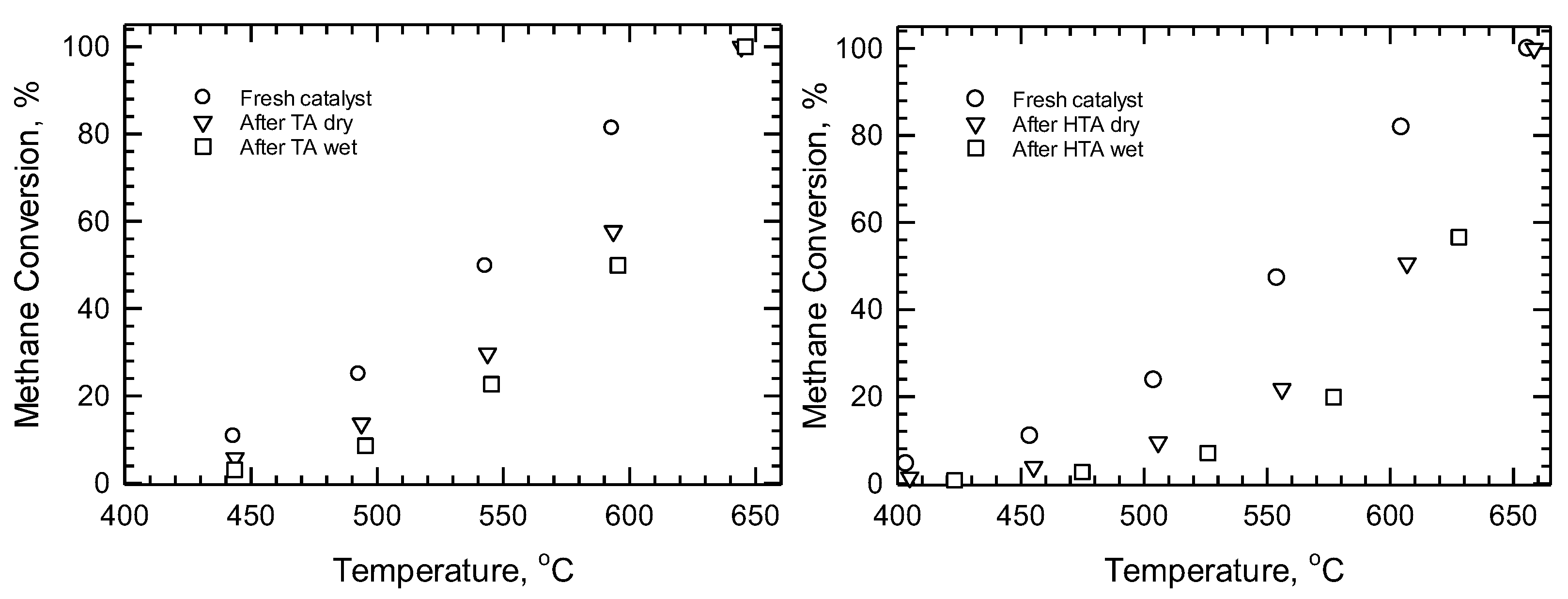
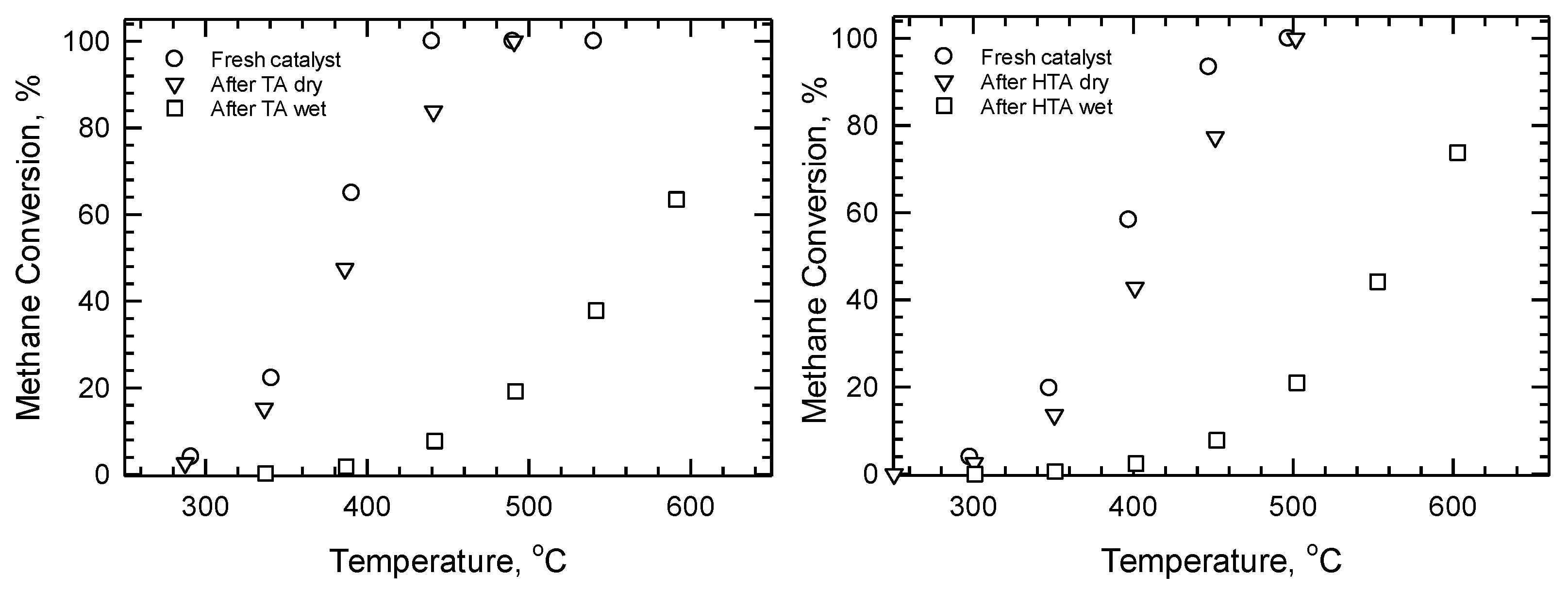

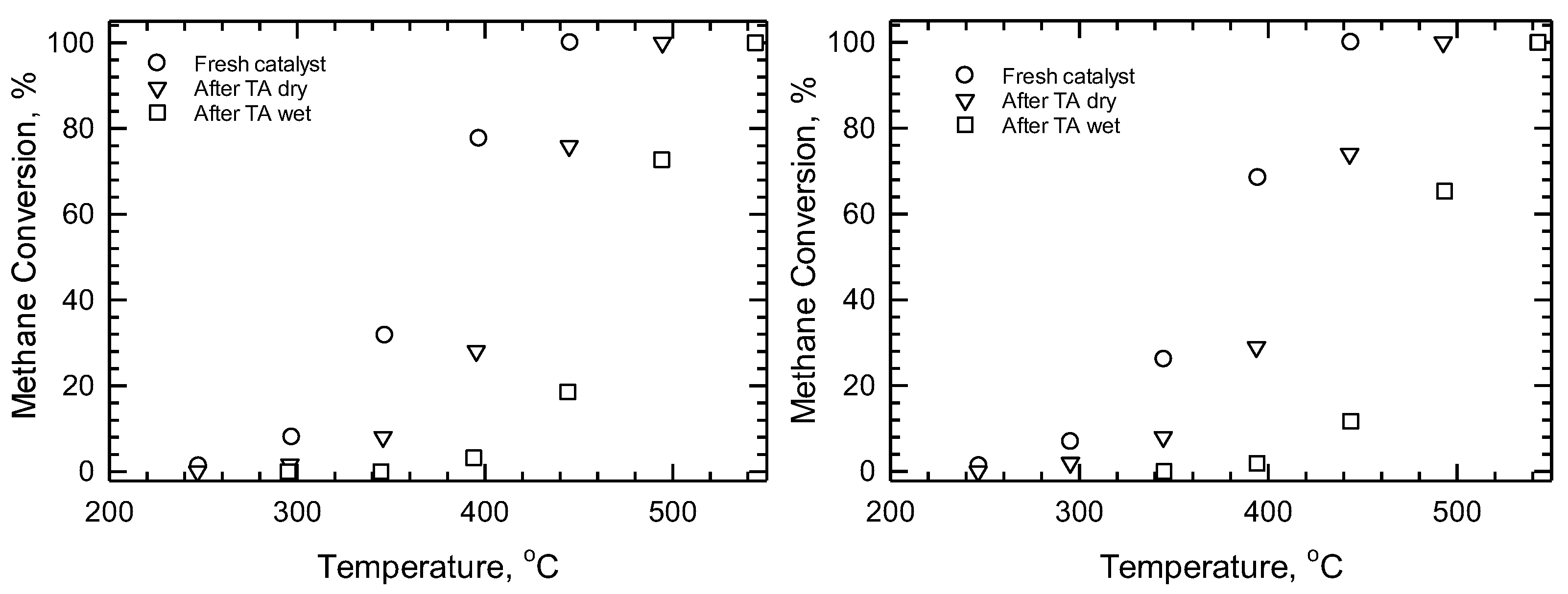
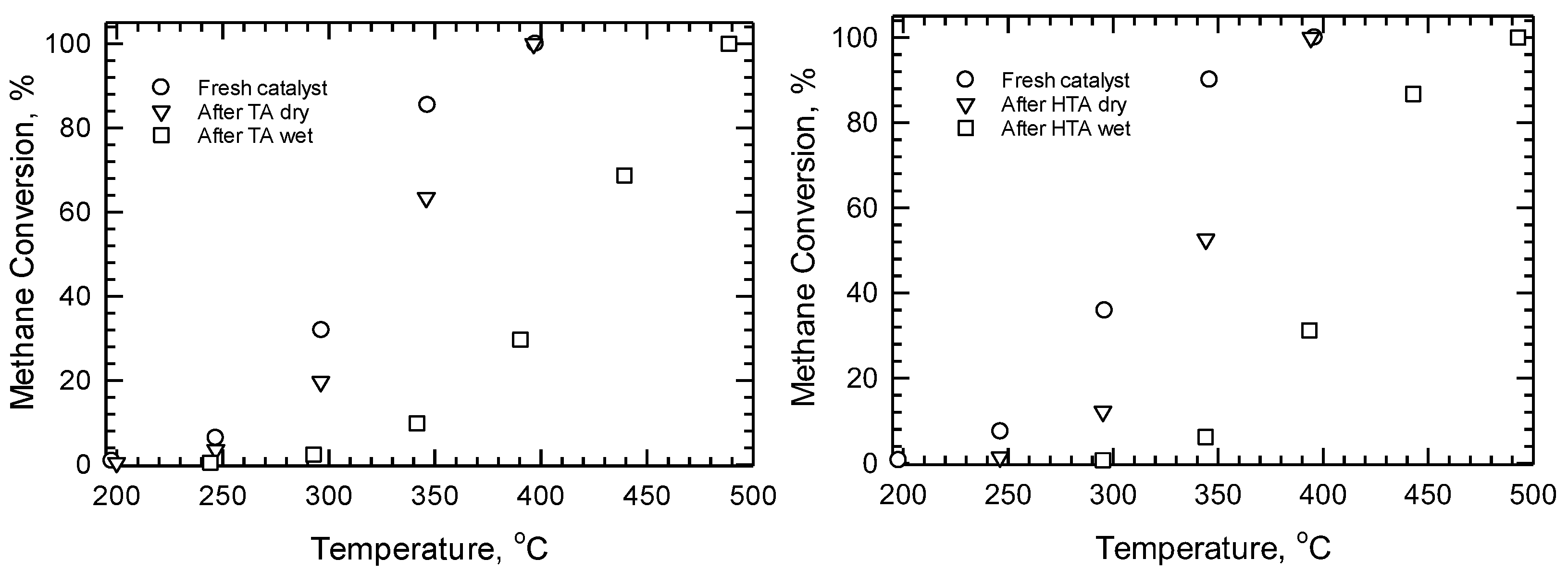



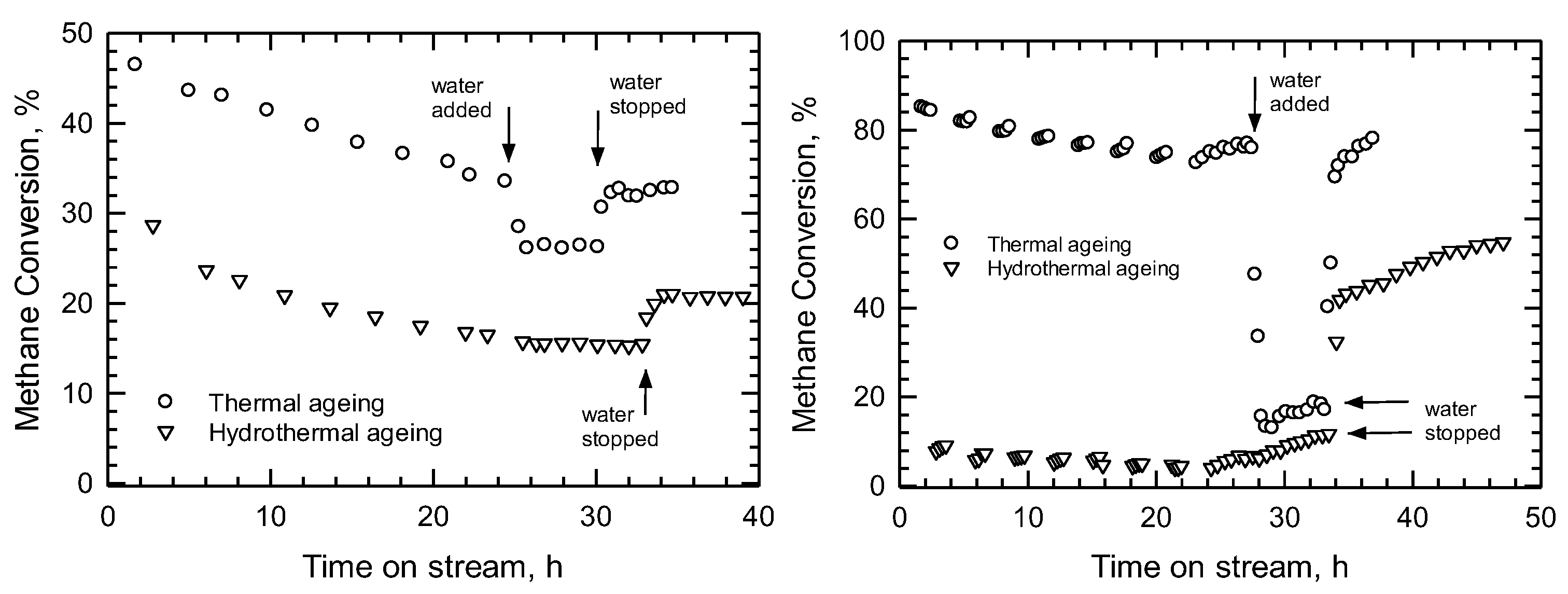




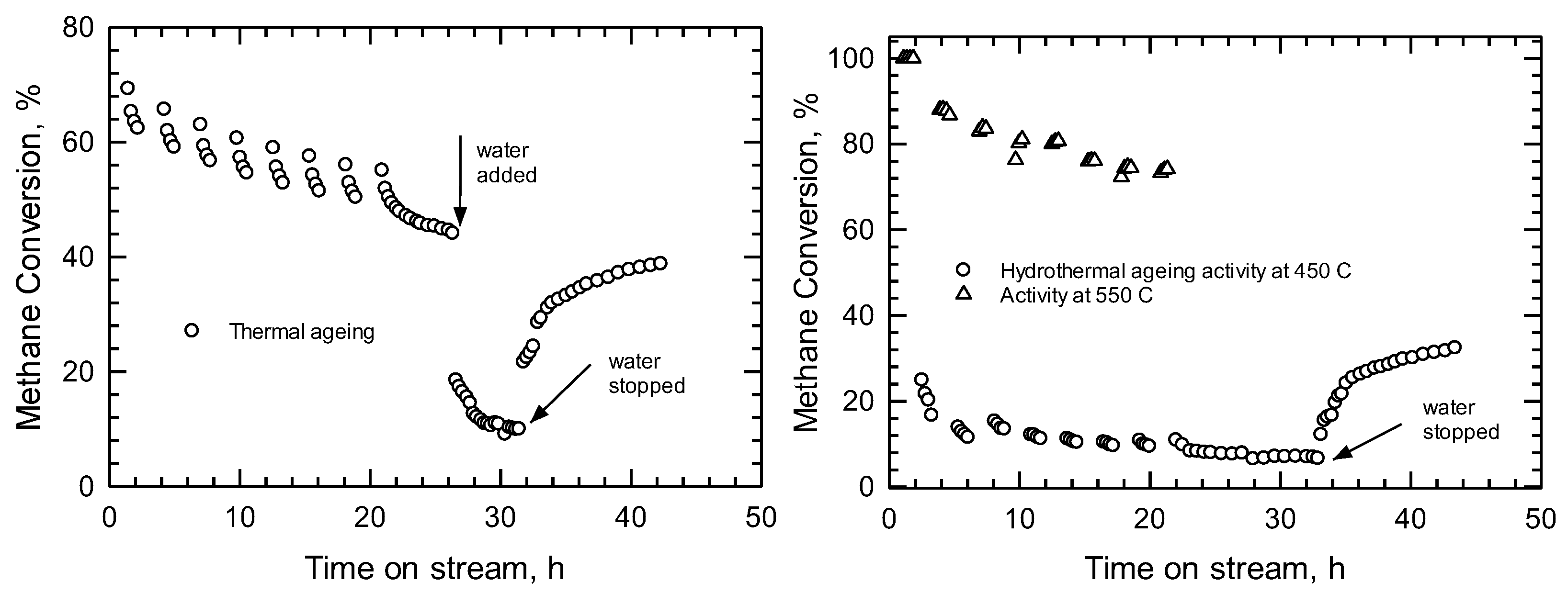

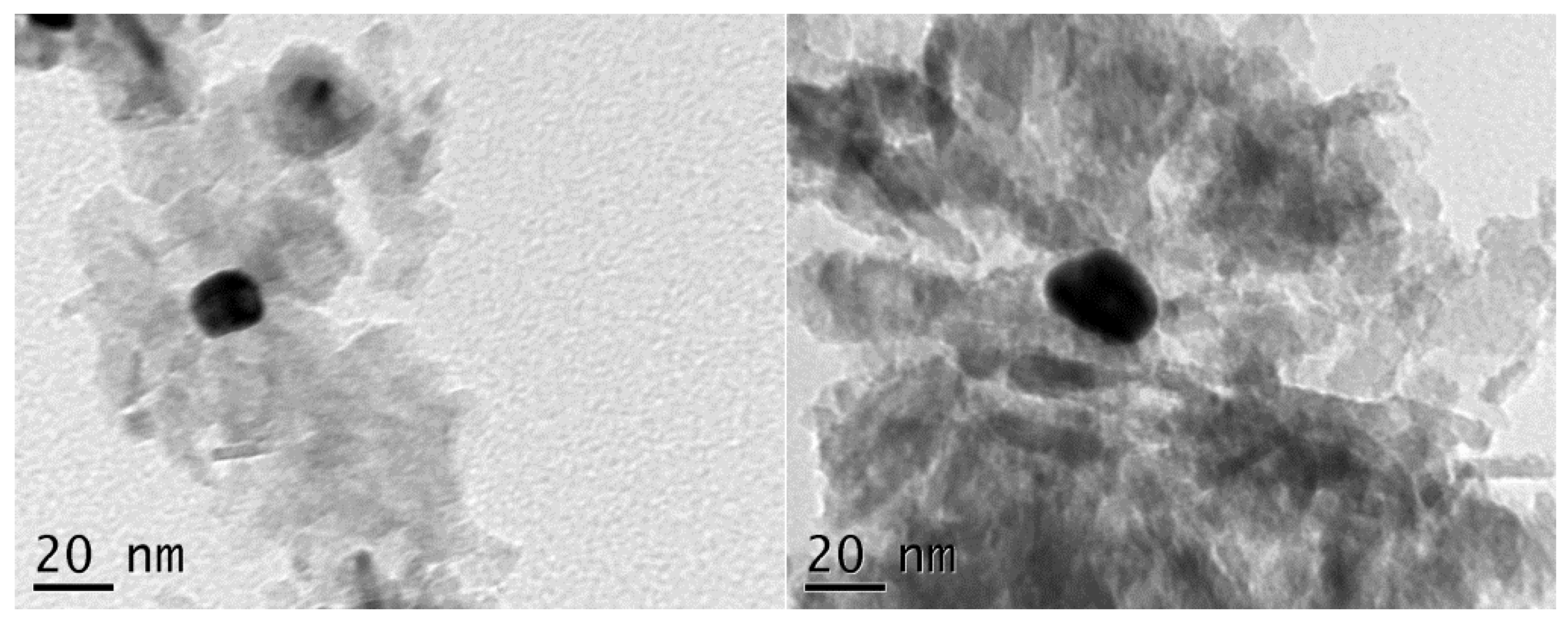

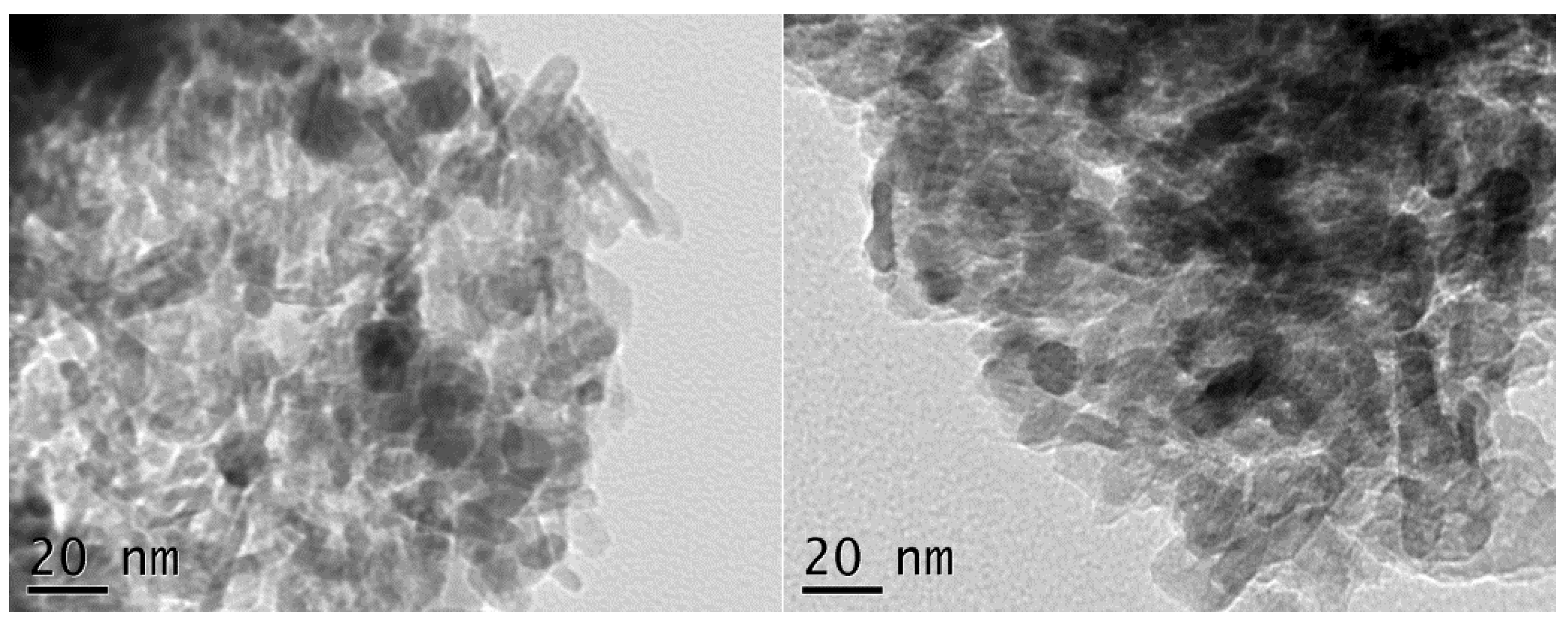
| PGM Loading on Monolith g/ft3 | Mass % PGM in Washcoat | |||||
|---|---|---|---|---|---|---|
| Designation | Pt | Pd | Rh | Pt | Pd | Rh |
| Pt 95 | 95 | 2.54 | ||||
| Pt:Pd 95 | 76 | 19 | 2.03 | 0.51 | ||
| Pd 150 | 150 | 4.01 | ||||
| Pt:Pd 150 | 25 | 125 | 0.67 | 3.34 | ||
| Pd 122 | 122 | 3.26 | ||||
| Pd:Rh 120 | 117.15 | 2.85 | 3.13 | 0.076 | ||
| Pt:Pd:Rh 95 | 19 | 73 | 2.85 | 0.51 | 1.95 | 0.076 |
| Catalyst | TA Dry | TA Wet | HTA Dry | HTA Wet |
|---|---|---|---|---|
| Pt 95 | 37 | 53 | 48 | 61 |
| Pt:Pd 95 | 17 | 192 | 26 | 177 |
| Pd 150 | 53 | 143 | 74 | 157 |
| Pt:Pd 150 | 18 | 103 | 32 | 101 |
| Pd 122 | 51 | 106 | 44 | 106 |
| Pd:Rh 120 | 52 | 104 | 66 | 119 |
| Pt:Pd:Rh 95 | 50 | 106 | 55 | 111 |
| Pt 95 catalyst aged at 650 °C | ||||||
| Conversion | Fresh | TA dry | TA wet | Fresh | HTA dry | HTA wet |
| 25 | 493 | 529 | 550 | 506 | 562 | 584 |
| 50 | 543 | 580 | 596 | 558 | 606 | 619 |
| 75 | 583 | 614 | 621 | 595 | 632 | 650 |
| Pt:Pd 95 catalyst aged at 650 °C | ||||||
| Conversion | Fresh | TA dry | TA wet | Fresh | HTA dry | HTA wet |
| 25 | 344 | 351 | 507 | 354 | 370 | 511 |
| 50 | 373 | 390 | 565 | 386 | 412 | 563 |
| 75 | 405 | 428 | 608 | 421 | 448 | 608 |
| Pd 150 catalyst aged at 550 °C | ||||||
| Conversion | Fresh | TA dry | TA wet | Fresh | HTA dry | HTA wet |
| 25 | 301 | 353 | 435 | 304 | 372 | 459 |
| 50 | 323 | 376 | 466 | 334 | 410 | 491 |
| 75 | 345 | 399 | 486 | 363 | 442 | 515 |
| Pd 122 catalyst aged at 550 °C | ||||||
| Conversion | Fresh | TA dry | TA wet | Fresh | HTA dry | HTA wet |
| 25 | 333 | 388 | 450 | 342 | 389 | 456 |
| 50 | 367 | 418 | 473 | 373 | 417 | 479 |
| 75 | 394 | 444 | 498 | 405 | 445 | 507 |
| Pt:Pd 150 catalyst aged at 550 °C | ||||||
| Conversion | Fresh | TA dry | TA wet | Fresh | HTA dry | HTA wet |
| 25 | 283 | 302 | 379 | 277 | 311 | 381 |
| 50 | 313 | 331 | 416 | 309 | 341 | 410 |
| 75 | 337 | 362 | 449 | 332 | 368 | 432 |
| Pd:Rh 120 catalyst aged at 550 °C | ||||||
| Conversion | Fresh | TA dry | TA wet | Fresh | HTA dry | HTA wet |
| 25 | 345 | 387 | 454 | 345 | 400 | 458 |
| 50 | 370 | 422 | 474 | 372 | 438 | 491 |
| 75 | 396 | 456 | 495 | 402 | 477 | 527 |
| Pt:Pd:Rh 95 catalyst aged at 550 °C | ||||||
| Conversion | Fresh | TA dry | TA wet | Fresh | HTA dry | HTA wet |
| 25 | 365 | 410 | 472 | 363 | 409 | 473 |
| 50 | 405 | 455 | 511 | 401 | 456 | 512 |
| 75 | 436 | 489 | 543 | 430 | 496 | 545 |
Disclaimer/Publisher’s Note: The statements, opinions and data contained in all publications are solely those of the individual author(s) and contributor(s) and not of MDPI and/or the editor(s). MDPI and/or the editor(s) disclaim responsibility for any injury to people or property resulting from any ideas, methods, instructions or products referred to in the content. |
© 2023 by the authors. Licensee MDPI, Basel, Switzerland. This article is an open access article distributed under the terms and conditions of the Creative Commons Attribution (CC BY) license (https://creativecommons.org/licenses/by/4.0/).
Share and Cite
Istratescu, G.M.; Hayes, R.E. Ageing Studies of Pt- and Pd-Based Catalysts for the Combustion of Lean Methane Mixtures. Processes 2023, 11, 1373. https://doi.org/10.3390/pr11051373
Istratescu GM, Hayes RE. Ageing Studies of Pt- and Pd-Based Catalysts for the Combustion of Lean Methane Mixtures. Processes. 2023; 11(5):1373. https://doi.org/10.3390/pr11051373
Chicago/Turabian StyleIstratescu, Georgeta M., and Robert E. Hayes. 2023. "Ageing Studies of Pt- and Pd-Based Catalysts for the Combustion of Lean Methane Mixtures" Processes 11, no. 5: 1373. https://doi.org/10.3390/pr11051373





